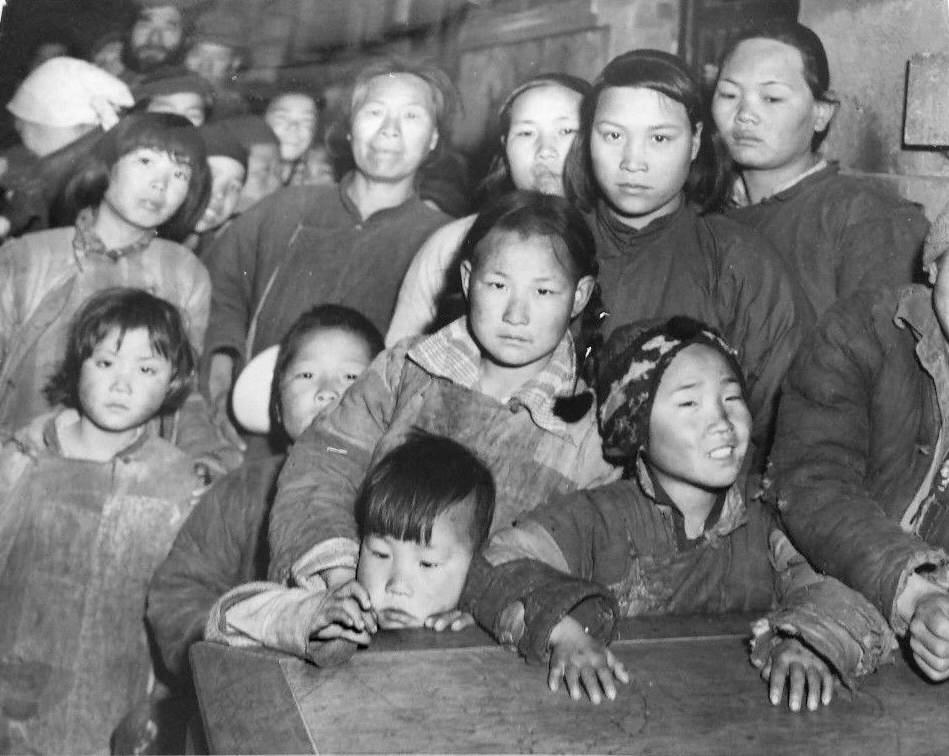
Chinese Civil War: Renewed Fighting--The Final Phase (1945-49)

Figure 1.--These refugees are in Shanghai, fleeing advancing Communist forces. The photograph was taken May 2, 1949. Inless they can get on a boat to Taiwan they can only wait the arrival of the People's Libration Army.that had crossed the Yangzi River. The press caption read, "An Old Story Re-told in China: Flight from terror is not new in China, where minor and major wars have been the rule for decades. Shanghai is the newest 'c????? dreadful night' for thousands of refugees who fled before advancing Communist armies. Tey wonder about te city asking for food. The above group is typical. Today Shanghai is reportedly cmpletely cut off, the Communists having severed the last remaining esce corridor. The Nationaliss indicate that they will put up at leat aoken defense of the city as machine guns are mounted in Sganghai's famous hotels and public buildings."
|
|
KMT Warlord and military commander Li Zongren hoped to hold southern China by making a stand at the Yangzi River. The Yangtze is the major river floing through central China, seprasting the north and south. Li tried to negotiate with Mao. Mao had no intention of negotiating having defeated the principal KMT field armies. He insisted on his eight-point surrender program. Li Zongren refused the ultimatum. The British ordered the Amethyst frigate up the Yangzi to Nanjing to evcuate their embassy. PLA forces fired on it killing 17 sailors (April 7, 1949). Other British ships aempted to reach Nanking, but were unable to do so., Mao ordred the PLA to cross the Yangzi (April 21). With many if the strongest KMT units destoyed in the northern fighing, the PLA swept south. KMT resistance collapsed. The PLA quickly took Nationalist-controlled cities and with each victory they gaining increasing popular support. The PLA enter Nanking (April 23). The LA took Hangzhou, Shanghai, Nanchang, and Wuhan with little fighting (May). Shanghai on the Yangziwas was China's principal port and the business and commercial center of China and the major prize in the Civil War. Yan Xishan in Shanxi tried to hold on to his power by using thousands of Japanese troops that had not been repstristed. The PLA entered Taiyuan (April). He set fire to the prison holding Communist prisoners and then committed suicide. Peng Dehuai led a PLA Army west and took Xi’an defended by a Muslim general from Gansu. He then entered Lanzhou (August) before moving into Xinjiang. Lin Biao’s forces captured Changsha (August) as the Communists took control of Hunan, Hubei, and Fujian. As the PLA swept south, CPC operatives rounded up and summrily excuted those they saw as enemies. Guangzhou fell to the Communits (October 13) The PLA occupied Guizhou and Sichuan (November). The remiming KMT forces defended Xiamen as more Nationalists fled to Taiwan. Xiamen fell (December 9). KMT forces held out for a time in southwest China.
CIH

Related Chronolgy Pages in the Boys' Historical Web Site
[The 1880s]
[The 1890s]
[The 1900s]
[The 1910s]
[The 1920s]
[The 1930s]
[The 1940s]
[The 1950s]
[The 1960s]
[The 1970s]
[The 1980s]
[The 1990s]
[The 2000s]
Navigate the Children i History Website
[Return to the Main remewed Chinese CivilWar page]
[Return to the Main Pacific War China page]
[Return to the Main Chinese Civil War page]
[Return to the Main Chinese 20th century history page]
[Introduction]
[Biographies]
[Chronology]
[Climatology]
[Clothing]
[Disease and Health]
[Economics]
[Geography]
[History]
[Human Nature]
[Law]
[Nationalism]
[Presidents]
[Religion]
[Royalty]
[Science]
[Social Class]
[Bibliographies]
[Contributions]
[FAQs]
[Glossaries]
[Images]
[Links]
[Registration]
[Tools]
[Children in History Home]
Created: 10:23 AM 7/9/2014
Last updated: 10:23 AM 7/9/2014



